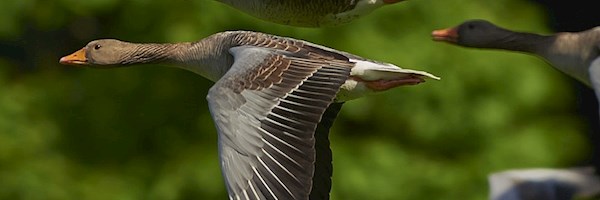There are many attractive plants that will offer nesting material and food for birds as well as shelter from predators and rough weather.
To create a bird-friendly garden you need to plant layers of vegetation, in the same way as plants grow in the wild. Trees are the tallest specimens. Underneath grow the understory level of smaller trees and shrubs, which can usually thrive in partial shade. At ground level will be herbaceous perennials, annuals and groundcovers. In addition, some vines and climbers grow by climbing up trees and through shrubs to get to the light.
Sunlight filters through the layers to the garden floor, where you can place fallen logs that will harbour fungi and mosses. These are ideal nesting materials for birds, and also provide a haven for insects which birds feed on.
Trees
Canopy trees are where birds like to perch to keep a lookout for predators or prey. Weavers attach their hanging nests to branches, and sunbirds and other small birds use forked branches as sturdy bases for their homes.
In large gardens, the following trees will provide canopies of shade:
White stinkwood (Celtis Africana)
Wild peach (Kiggelaria Africana)
Acacias
Cape chestnut (Calodendrum Capensis).
For smaller gardens, the following are ideal shade trees:
White karee (Rhus Pendulina)
Tree fuchsia (Halleria Lucida)
Boerbean (Schotia Brachypetala)
Tree wisteria (Bolusanthus Speciosus)
Ornamental cherry
Shelter
A thicket of shrubs and groundcovers in a secluded part of the garden provides protection from predators as well as acting as a safe place to build nests.
Leaves, twigs, grasses and reeds provide nesting material. Dead trees make ideal nesting holes, or you can attach nesting logs and boxes high up in trees. Make sure the entrances are protected from rain and wind.
Easy to grow Cape honeysuckle has attractive tubular flowers in orange, salmon or yellow which attract sunbirds. It is also a useful hedge or screening plant.
Plumbago, with its blue or white flowers, makes an attractive hedge and attracts butterflies, which in turn attract birds.
The thorny Carissa macrocarpa provides a protection from predators, and its berries are a source of food for many bird species.
Food
Different birds will need different foods. Sunbirds and white eyes need nectar and occasional insects, whereas wagtails and hadedas will look for insects and worms in open spaces and on lawns.
Fallen leaves and dry twigs under shrubs and in hedges, as well as mulching with leaves and garden clippings, will provide food for foraging robins and thrushes.
A variety of plants will provide nectar, berries, seeds and fruits throughout the year. They should be planted in groups so that birds can easily find them.
To attract nectar-loving birds plant a selection of these shrubs:
Aloes
Cape honeysuckle
Buddleja salviifolia
Bottlebrush
Wild dagga (Leonitis leonurus)
Wild pomegranate (Burchellia bubalina)
Hibiscus
Pincushion Proteas
Strelitzia regina
Beach salvia
Ribbon bush (Hypoestes aristata)
Starry wild Jasmine (Jasmine multipartitum)
Bladdernut (Diospiros whyteana)
Nectar-lovers are also attracted to flowering plants like:
Red hot poker (Kniphofia)
Pineapple sage
Salvia
Fuchsias and tree fuchsias
Crocosma
Small-fruit eaters like the white eyes also enjoy the berry-like fruits of tree fuchsias and Carissa macrocarpa.
Water
All birds need fresh water for drinking and bathing, and a wide range of bird baths is available to suit gardens of all shapes and sizes.
A bird bath on a pedestal is ideal for gardens that are visited by cats. Ground-level bird baths will also be attractive to frogs and other small animals.
The water should always be fresh, and bird baths should be regularly scrubbed to remove algae.
If the water is too deep for small birds, place a few stones in the bath basin so that they have a place to perch.
Feeders
Bird feeders filled with birdseed and sugar water, and bird tables with fruit and other delicacies such as peanut butter will also attract birds to your garden.
Hang feeders in or near trees so that birds can easily hide from raptors and cats.
Feeders should have roofs to protect the seed from rain, as damp seeds can go mouldy.
Fill feeder bottles with sugar water made with fructose instead of granulated sugar. This mixture is closer to nectar-feeders' natural food and also has the advantage of not fermenting as quickly as ordinary sugar water.
Once you have planted your bird-friendly garden, be patient. Don't despair if you don't immediately have plenty of birds in your garden. Activity will certainly build up over the years as more birds get to know that your garden is a source of food and shelter.
